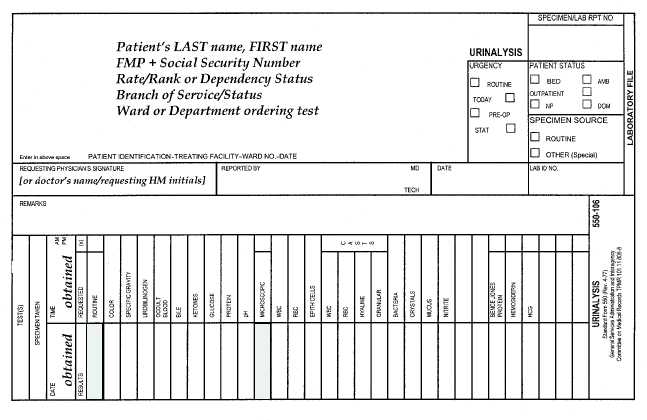their spaces. Once healthcare providers enter their test
requests, patients may report immediately to the
Laboratory Department, where specimens are
obtained and tests are performed.
Use of Laboratory Request Forms
Write information on the SF laboratory request
forms in black or blue-black ink. Use a separate SF
laboratory request form for each patient and for each
test. Document the patient’s full name, family member
prefix and social security number, rate/rank,
dependency status, branch of service, and status in the
“Patient Identification” block. Also identify the ward
or department ordering the test in this block. See figure
7-1 for an illustration of the Urinalysis request form,
SF-550. Computer-generated laboratory test requests
require the same patient identification data as SF
laboratory requests.
Since the results of the requested laboratory test
are usually closely associated with the patient’s health
and treatment, the requesting healthcare provider’s
name should also be clearly stated in the “Requesting
Physician’s Signature” block on the request form
(fig. 7-1). The doctor requesting the urinalysis should
sign in this block. Alternatively, you may type/print
the doctor’s name in the block and initial the entry to
authenticate it. This practice ensures that the report
will get back to the provider as soon as possible.
Enter the requested test in the “Remarks” block
(e.g., “Clean catch midstream to R/O urinary tract
infection”). Because the data requested, the date
reported, and the time of specimen collection are
usually important in support of the clinical picture,
these pieces of information should be clearly written
on the request in the areas provided for them (fig. 7-1).
Patient and Specimen Identification
Before accepting laboratory request forms and
s p e c i m e n s i n t h e l a b o r a t o r y, c h e c k p a t i e n t
identification information on both the request form and
the specimen container label for completeness and
legibility.
Proper documentation of patient
identification information on these items can prevent a
great number of errors.
Also, make sure the
specimen(s) submitted is in fact the specimen of the
patient submitting it. You need not stand over the
patient while the specimen is being collected;
however, keep in mind that for certain tests (such as
drug or alcohol screening tests) individuals may
attempt to substitute specimens.
7-2
HM3f0701
Figure 7-1.—SF-550, Urinalysis Request Form.


